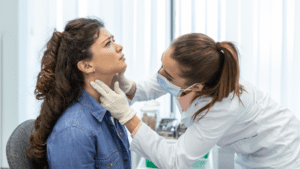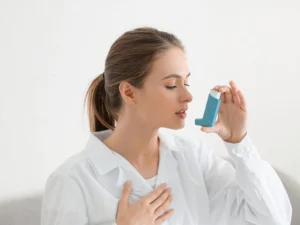The topmost layer of our human body, skin, acts as a protective barrier against mechanical, physical, and thermal injuries. So, the skin helps in reducing the harmful effect of Ultraviolet radiations and regulated body temperature. Furthermore, it regulates the production of vitamin D and acts as a sensory organ for various receptors.
Skin Problems
Skin problems can occur due to situational causes or genetic factors and can be temporary or permanent. So, bacteria trapped in skin pores, viruses, fungus, allergens, genetic factors, and irritants are common causes of skin disorders.
Urticaria (Hives)
Hives are a skin problem resulting in raised welts on the skin. Hives are generally caused by allergic reactions and appear pinkish-red in color. Allergens such as pollen, medications, animal dander, dust mites, insect stings, and food items cause Urticaria. Hives are round-shaped welts, itchy in nature, and pinkish-red in appearance. Hence, in severe life-threatening allergic reactions, hives appear with breathing difficulties, dizziness, and nausea. Furthermore, health conditions such as thyroid disease, type 1 diabetes, celiac disease, or lupus, hives cause chronic problems.

Acne Vulgaris
Most acne problems are very commonly observed in individuals causing whiteheads, blackheads, and pimples. Acne forms due to oily dead skin cells and hair follicles on the uppermost layer. Therefore, acne can lead to emotional distress, darkening of the skin, and scar formation if not treated.
Symptoms Of Acne Vulgaris
- Growth of close plugged whiteheads pores
- Growth of close plugged blackheads pores
- Big solid lumps under the skin
- Appearance of pimples
- Cystic lesions
Atopic Dermatitis
Atopic dermatitis is also known as eczema that leads to redness and itchiness in the skin. Usually, it develops in early childhood, common in people having a family history. Atopic dermatitis may develop due to heat, sweat, hot showers, physical irritants such as dirt, dust, allergens such as pollen, strenuous exercise, and scratching. Although there is no known cure for eczema, moisturizing the skin can help to provide a soothing effect.
Symptoms Of Atopic Dermatitis
- Extremely dry, scaly, and itchy skin
- The appearance of light and dark skin spots
- Rashes on scalps or cheeks
- The rashes increases of elbows and knees
- Rashes on neck, face, and around the eyes
- Liquid discharge from developed rashes
Actinic Keratosis
Actinic Keratosis is a chronic skin problem in which scaly spots develop on the skin. These spots are called sunspots or age spots and can be brown, tan, grey or maybe pink. Actinic Keratosis spots are visible on body parts that are in direct exposure to sunlight such as hands, arms, face, scalp, and neck. Individuals who are above 60 years of age are more likely to develop Actinic Keratosis. Light-complexioned and blue-eyed people are at a greater risk of developing skin spots. Furthermore, individuals who are exposed to the sun and get a sunburn to show the development of Actinic Keratosis spots on their bodies. Therefore, people need to apply sufficient SPF sunscreen to protect their skin from sunburn and diseases.
Symptoms Of Actinic Keratosis
- Thick, scaly, and colored skin patches/ spots
- Rapid enlargement of spots
- Redness and inflammation in affected areas
- Hardening of the skin lesions
- Ulceration
Cellulitis
Bacteria or fungus causes a painful skin infection that is Cellulitis. So mostly, the skin of the lower legs is affected by cellulitis. The condition results in redness, pain, and swollen skin with or without oozing. If the infection becomes chronic and severe, high fever, chills, and red streaking also appears.
Symptoms Of Cellulitis
- Pain, redness, and tenderness in the affected body parts
- Presence of abscess with pus
- Inflammation of the affected area
- The appearance of skin sore or rash
- Fever, fatigue, dizziness, lethargy, and light-headedness
- Muscular ache with warm skin
- Blisters and red streaks
Basal Cell Carcinoma
Basal cells line the epidermal layer of skin protecting the body from UV rays and harmful stresses. When there is an abnormal division and growth of basal cells, basal cell carcinoma develops. Therefore, basal cell carcinoma is the cancer of basal cells of the epidermis.
Symptoms Of Basal Cell Carcinoma
- The appearance of pigmented skin- brown, black, translucent, raised border cells
- The appearance of reddish patch on scaly and flat skin
- Presence of scar-like lesion
- Presence of skin bumps which are white or pink
- Inflammation of the affected area
Conclusion
To sum up, skin problems and disorders occur due to infections caused by bacteria or fungus, allergens, cancer, or other reasons. Skin is an extremely essential sense organ for protecting against harmful mechanical, physical, and thermal stressors. Therefore, inflammation of the affected area, presence of skin sore or rash, fever, fatigue, dizziness, lethargy, light-headedness, whiteheads, blackheads, and pimples are some of the commonly observed symptoms in skin disorders. However, other symptoms of skin problems include cracked skin, the presence of raised bumps, lesions, peeling skin, discolored skin patches, development of ulcers, loss of skin pigments, or excessive flushing. Hence, treatment in time can save a lot of pain and trauma.




